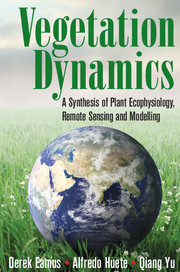Book contents
- Frontmatter
- Contents
- Preface
- Section One Plant Ecophysiology
- Section Two Remote Sensing
- Section Three Modelling
- 8 An Introduction to Modelling in Plant Ecophysiology
- 9 Modelling Radiation Exchange and Energy Balances of Leaves and Canopies
- 10 Modelling Leaf and Canopy Photosynthesis
- 11 Modelling Stomatal and Canopy Conductance
- 12 Modelling Leaf and Canopy Transpiration and the Soil-Plant-Atmosphere Continuum
- 13 Coupling Models of Photosynthesis, Transpiration and Stomatal Conductance and Environmental Controls of Leaf Function
- Section Four Case Studies
- Index
- References
11 - Modelling Stomatal and Canopy Conductance
from Section Three - Modelling
Published online by Cambridge University Press: 05 June 2016
- Frontmatter
- Contents
- Preface
- Section One Plant Ecophysiology
- Section Two Remote Sensing
- Section Three Modelling
- 8 An Introduction to Modelling in Plant Ecophysiology
- 9 Modelling Radiation Exchange and Energy Balances of Leaves and Canopies
- 10 Modelling Leaf and Canopy Photosynthesis
- 11 Modelling Stomatal and Canopy Conductance
- 12 Modelling Leaf and Canopy Transpiration and the Soil-Plant-Atmosphere Continuum
- 13 Coupling Models of Photosynthesis, Transpiration and Stomatal Conductance and Environmental Controls of Leaf Function
- Section Four Case Studies
- Index
- References
Summary
Introduction
Stomata are located at the critical interface between a leaf's internal and external environment. Stomata are the point of coupling between the flux of CO2 for photosynthesis and water for transpiration. Modelling stomatal conductance (gs) has a long history but mostly it has been empirical rather than mechanistic. Recently, however, this has changed and more mechanistic models are emerging. In this chapter various models that are currently used to describe stomatal and canopy conductance are discussed. The physiological basis of stomatal movements underpinning these models is discussed extensively in Chapter 2 while examples of stomatal behaviour in the field are presented in Chapters 14–18.
Stomata respond to environmental factors in such a manner that it not only protects the plant from excessive water loss, but also optimises water-use-efficiency (Cowan 1977, Chapter 2). Regulation of gs is a key element in mass flow through the soil-plant-atmosphere continuum (SPAC) with respect to water loss and carbon gain. Though much is known about stomatal behaviour in the field, a mechanistic model of field behaviour of stomatal conductance has been elusive. Mathematical simulation models of stomatal conductance are mostly semi-empirical, with a notable recent exception which is described more fully in Section 11.2 (Medlyn et al. 2011). Early work by Upadhyaya et al. (1983), and Fu and Wang (1994) are also noteworthy in their attempts to construct mechanistic models which include leaf water potential, photosynthetic electron transport, and ion fluxes, into or out of the guard cells. These models, though more analytical, are rarely applied today because they contain variables which are either not readily measurable or they are rarely measured by ecophysiologists.
Although many studies simulate stomatal behaviour and there are multiple combined photosynthesis-stomatal conductance models, systematic analysis of physiological responses to environmental variation has rarely been undertaken. This is despite the primary importance in model building of the need to construct a sound mechanistic framework so that observed phenomena can be simulated under widely different environments and circumstances.
During numerical analysis of physiological responses it is important to study the sensitivity of outputs to variation in inputs. Models of physiological responses to environmental factors have a wide range of use in the modelling of crop yield, forest growth, and dynamic global vegetation models and land surface exchange models.
- Type
- Chapter
- Information
- Vegetation DynamicsA Synthesis of Plant Ecophysiology, Remote Sensing and Modelling, pp. 281 - 295Publisher: Cambridge University PressPrint publication year: 2016

